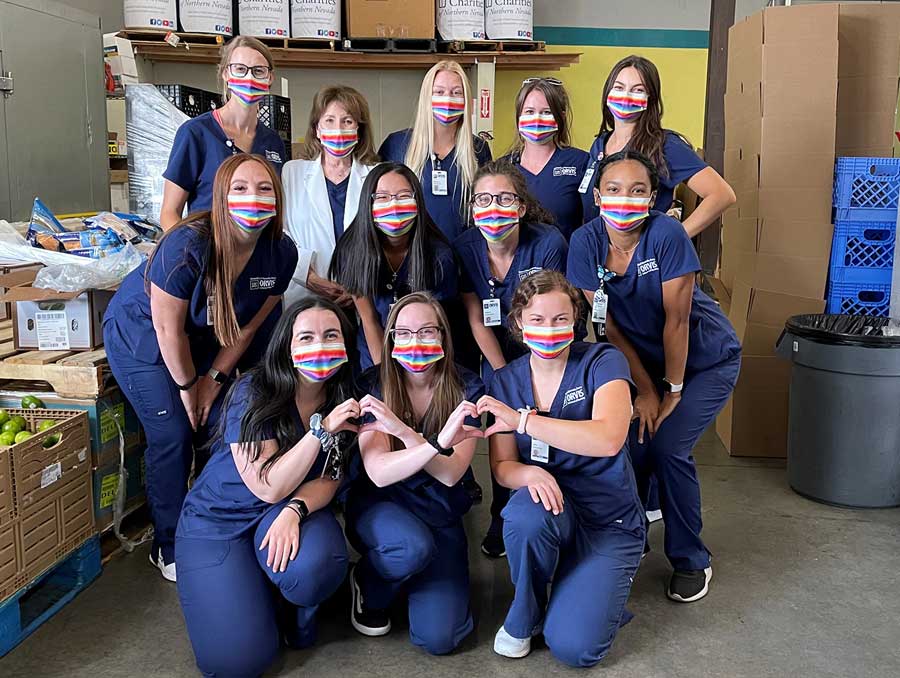As students and faculty prepare for a full return to campus, Lisa Thomas, Ph.D., RN, CNE, FAAN, and Associate Professor for the Orvis School of Nursing, has been conducting research on the impact of COVID on undergrad students and how faculty and the university can help prepare students for a full-time return to campus.
From her findings, Thomas discovered that nursing students have mentally fared better during COVID than other undergrads. But it begs the question as to why?
According to Thomas’ research, statistically, nursing students have struggled less with depressive symptoms during COVID, despite the fact that their academic stress has been higher.
“The degree in which COVID has impacted the overall experience of nursing educational programs has been higher, yet nursing students’ depression scores are lower.”
The reason stems from the fact that despite the social separations that arose from COVID, nursing students still had a sense of community during the pandemic. While most undergrads were sent home to continue their studies off-campus, nursing students have always had some level of in-person interaction with each other and other people.
While Thomas’ research focused on nursing students, they were not the only department on campus to experience a more hybrid model during COVID.
The link between mental health and undergrads
Prior to COVID, research showed that isolation by itself exasperates depression. For college students there is the addition of academic stress. Combine these two and you already have a bad combination for mental health. Now, add in a pandemic.
For years, professionals have been talking about the overall decline in mental health on college campuses. As parenting styles have changed, kids are becoming less resilient. Today, 1 in 3 college students suffers from some kind of mental health diagnosis. Prior to COVID, the number of students who had attempted to harm themselves doubled from 2009-2019.
“We have this existing mental health crisis on campus and then COVID happens and we’re adding isolation, loneliness, stress, uncertainty, and what you end up with is a really scary situation,” explained Thomas. “People are starting to research the impact this time has had on college students, but it’s not well captured yet.”
How the University and faculty can help students transition back onto campus
What we do know is that COVID itself added immense levels of academic stress to students. Suddenly, they were faced with additional barriers to reaching their goals, feeling like they’re letting themselves and their families down and added financial stress from losing jobs or being forced to move back home. Thomas’ research has found that upwards of 80% of college students have said the pandemic-related closures affected their mental health.
Now, after more than a year of online learning, students are transitioning back to being on campus. Based on her research, Thomas says there are numerous learnings on how important it will be to support the development of the community that students need so badly to succeed.
- Prioritize students first
When students were sent home to learn remotely, there was a sense of chaos from students and faculty. In Thomas’s research, students expressed that the uncertainty from faculty preparedness to teach remote added to their overall stress of learning remote. Faculty now have to consider how students best learn and how they’re teaching in order to fully prioritize student success.
- Create a sense of community
Community is what helped some undergrads fare better under COVID than others. We, as a community and University, need to be putting things in place to support students. That support might look like opportunities to be engaged as part of the community and chances for students to develop community identity based on their interests and where they’re at now.
- Understand that it will take time
Thomas’s research shows that students have felt isolated and marginalized. As we welcome them back, things will not immediately go back to pre-COVID social structures. It’s going to be very different for a while and it’s our job to support students during this transition.
Thomas is continuing to conduct her research and look at the impacts COVID has had on undergrads and how it will continue to impact them throughout their undergrad academics. In the meantime building, a sense of community and belongingness will help students transition back onto campus for the fall semester and beyond.















